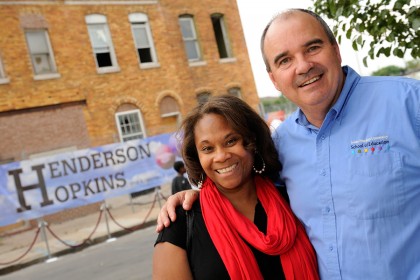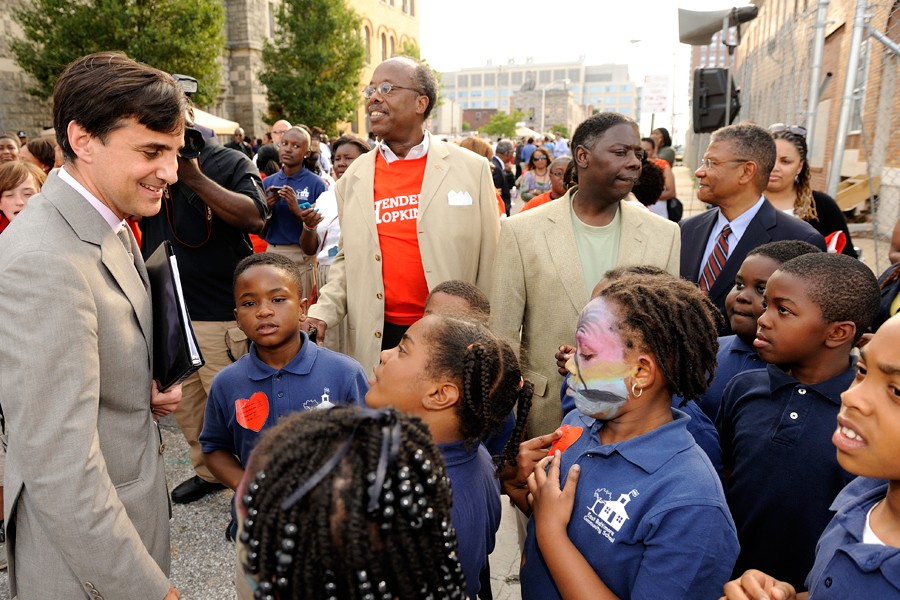More than 300 East Baltimore students, residents and supporters joined Baltimore Mayor Stephanie Rawlings-Blake, other city and state officials and Ronald J. Daniels, president of The Johns Hopkins University, on June 12 for the ceremonial groundbreaking of a new $43 million elementary school and The Harry and Jeanette Weinberg Early Childhood Center.

Image caption: Johns Hopkins School of Education Dean David Andrews (right) and Dr. Annette Anderson, assistant dean for community schools at the School of Education, attend the groundbreaking ceremony for the new Henderson-Hopkins school in East Baltimore.
Image credit: Will Kirk / Johns Hopkins University
The event also marked the official change of the school's name from the East Baltimore Community School, which has been operating from a modular-building campus for three years, to Elmer A. Henderson: A Johns Hopkins Partnership School. The Henderson-Hopkins school is the first new school in East Baltimore in more than 25 years.
Both the school and the early childhood center are expected to be completed in the 2013-14 school year and will be operated by the Johns Hopkins School of Education working in partnership with Morgan State University's School of Education and Urban Studies.
"The Henderson-Hopkins school represents the most important investment to date toward EBDI's goal of creating a thriving, vital and inclusive community," Daniels says, referring to the East Baltimore Development Inc. initiative. "We envision this world-class new campus to become the center of the community, open to everyone—every day, evenings and weekends."
The school will employ the most effective and evidence-based programs to improve student performance. As a community school, Henderson-Hopkins will adopt a focus on academics, health and social services, and youth and community engagement, which will lead to improved student learning, stronger families and healthier communities.
"We are planning a high-impact, high-quality school that will provide the children of East Baltimore with an outstanding educational experience that will prepare them for success in school and life," says David Andrews, dean of the Johns Hopkins School of Education, who lives a few blocks from the site. "We are also excited that other Johns Hopkins schools, such as the Peabody Institute and the schools of Medicine, Nursing and Public Health, will join us in this effort as we look at meeting the needs of the whole child."
Designed with flexible space to maximize opportunities for individualized and group learning, the building will adapt each classroom and common-space clusters to the changing needs of specific grade levels, and will incorporate active exterior learning spaces, including science/art terraces, roof gardens, playing fields, a student gallery, weather stations and a school garden and orchard. The campus will include a family support center, gymnasium, auditorium and library, all available for community use.
At capacity, the Henderson-Hopkins school and early child care center will have 540 and 180 students, respectively. Priority access to the school will be given to residents of the EBDI project area and relocated families. The next priorities are siblings, children of nearby employers, children from surrounding East Baltimore neighborhoods and then citywide families.
In addition to Johns Hopkins, the Weinberg, Annie E. Casey, Rouse Co. and Charlesmead foundations provided critical capital funding support. The Windsong Trust also provided the School of Education with a startup grant for equipment, curriculum design, teacher recruitment, professional development, and the development and implementation of a personalized platform.
Posted in University News, Community
Tagged east baltimore, president ron daniels, community









